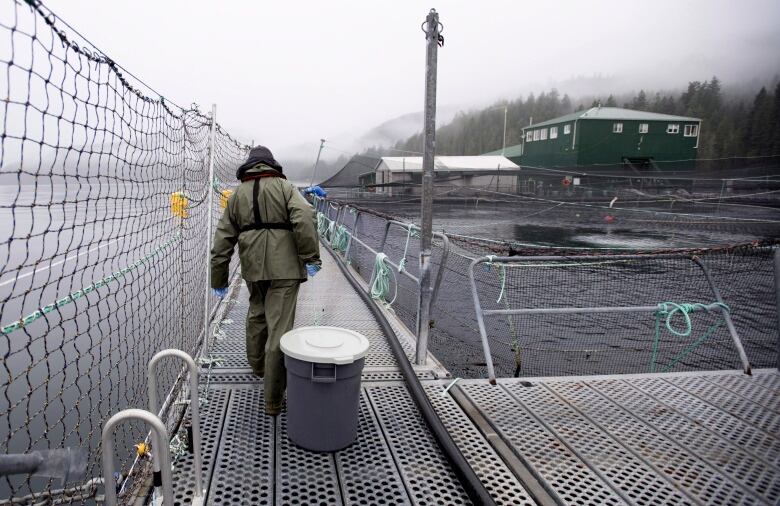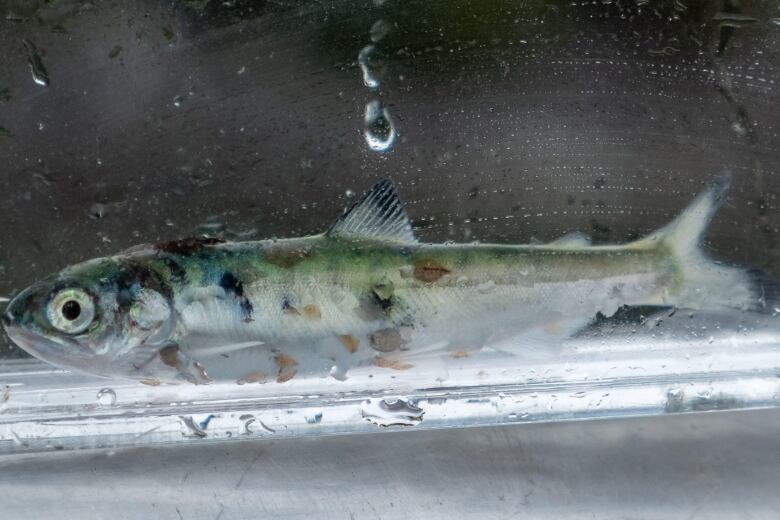B.C. fish farms regularly under-count sea lice, potentially putting wild salmon at risk: study
High numbers of aquatic parasites mean companies have to pay for costly delousing treatments

Salmon farms in B.C. waters appear to be significantly under-counting the number of sea lice on their fish, making it less likely they'll have to pay for delousing treatments to protect wild stocks, according to a new study.
The research, published Wednesday in the journal Ecological Applications, is based on an analysis of publicly available data from 91 aquaculture operations in the provincebetween2011 and 2016.
The study shows mandatory sea lice counts performed by the operators of thefish farms dropby between 15 and 50 per cent when they're not being done during an audit by Fisheries and Oceans Canada (DFO).
"That isn't really a minor effect. This is a pretty obvious result," said lead researcher Sean Godwin, who conducted the research for his PhD at Simon Fraser University.
Salmon farms are required to perform monthly counts of the sea lice on their fish and make those numbers publicly available. The counts are self-reported, but fisheries officials perform occasional, pre-arranged audits to make sure the numbers are accurate.
If the lice counts pass a certain threshold, the operators are required to pay for delousing treatments.
"These treatments are expensive, and so there's obviously a potential conflict of interest there in that the farms are the ones counting the sea lice," Godwin said.
The BCSalmon Farmers' Association strongly disputed the findings of the study on Thursday, saying the authors relied on a self-created, "unique, complex model" to draw itsconclusions.
"This report is flawed," said spokesperson Shawn Hall.
"Even if you accept the model, and we don't ... the numbers of sea lice on farms would have still been well under the regulatory threshold under which treatment is required [from 2011 to 2016]," he added.
Parasitic sea lice occur naturally in the Pacific Ocean, but they tend to thrive in fish farms because of the high density of fish.
Sea lice don't generally harm adult fish, but when the parasites attach to the skin of young fish, they can weaken or even kill them.
'Implications for a lot of salmon'
Godwin's research shows that, during the months when the DFO was auditing sea lice counts, the numbers of the Caligus clemensi species jumped by a factor of 1.95 and Lepeophtheirus salmonis counts increased by a factor of 1.18.
That could have serious consequences for the health and future of wild salmon, Godwin argues.
"If fewer treatments are being performed and the salmon are being more exposed to more sea lice, that has implications for a lot of salmon," he said.
Asked to explain the discrepancy reported in the study, Hallsaid the variance is caused by the authors' model and indirect comparisons.
"In this particular case, it's because [the authors are]not actually comparing audits conducted by the DFO to actual sea lice data collected by salmon farmers. They're using a complex model ... to try to explain what sea lice counts should have been in the past, versus what they actually were, and they're reporting on variants from that model," he said.
"It's not accurate."

Hall also said 80 per cent ofAtlantic salmon farms in B.C. have been audited by a third party,Aquaculture Stewardship Council, and that those audits also include checks for sea lice.
He maintained that salmon farms do not under-report the number ofsea lice.
Deadline looming
The study comes at a significant moment for the future of salmon farming in B.C., just weeks before a deadline that could see farms banned from some waterways.
The 2012 Cohen Commission on the decline of sockeye in the Fraser River recommended that on Sept. 30, 2020, the federal fisheries minister should prohibit all net-pen salmon farming in the Discovery Islands "unless he or she is satisfied that such farms pose at most a minimal risk of serious harm to the health of migrating Fraser River sockeye salmon."

The islands, located between the mainland and Vancouver Islandnear Campbell River, are home to more than a dozen salmon farms.
"This commission actually recommended specifically that there needs to be data collection and availability on disease data and on sea lice data from salmon farms," Godwin said.
"What it didn't do is say that these counts have to be reported accurately, and so we're making our assumptions on the risks of aquaculture based on inaccurate data."
He said that if self-reporting isn't producing an accurate count of sea lice in fish farms, the federal government needs to switch things up, perhaps implementing strong incentives to produce accurate counts.
But, Godwin said,"The most obvious option would be to shift to independent third-party monitoring instead of letting the salmon farms count the sea lice themselves."












_(720p).jpg)


 OFFICIAL HD MUSIC VIDEO.jpg)
.jpg)



























































































